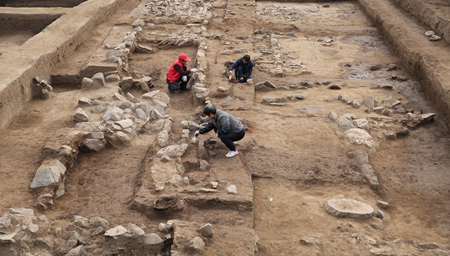Archaeological studies show new trend

Archaeologists work at the Liao Dynasty (907-1125) mining sites at Dazhuangke in Yanqing County, Beijing.
China's top 10 archaeological discoveries of 2014 were unveiled in Beijing on April 9. Discoveries honored in the competition hosted by the State Administration of Cultural Heritage were characterized by exploration of frontier regions and ancient ethnic groups.
The 10 discoveries were selected from 688 entries. They are the paleolithic sites at Nanjiang River and Modaoshan in Yunan County, Guangdong Province; the Dongzhao site in Zhengzhou, Henan Province; the cemetery of the Zeng State at Guojiamiao, Zaoyang, Hubei Province; the Dabona cemetery in Xiangyun County, Yunnan Province; the early Yueyao kiln site at Jinshan, Shangyu District, Shaoxing, Zhejiang Province; the Gurujiamu and Quta cemeteries in Ngari Prefecture, Tibet Autonomous Region; the Yihenaoer cemetery in Zhengxiangbai Banner, Inner Mongolia Autonomous Region; the Sui Dynasty (581-618) Huiluocang granary site in Luoyang and Liyangcang granary site in Junxian, Henan Province; the Liao Dynasty (907-1125) mining sites at Dazhuangke in Yanqing County, Beijing; and the cemetery of Bozhou Chieftain Yang’s family in Zunyi, Guizhou Province.
Compared to previous years, archaeological discoveries linked to ethnic groups of frontier provinces and autonomous regions in ancient times dominated this year’s top 10 list.
Wang Wei, director of the Institute of Archaeology (IA) at the Chinese Academy of Social Sciences and president of the Archaeological Society of China, pinpointed the rapid development of frontier archaeology as a noticeable trend in contemporary archaeological studies.
Archaeological research of frontier areas is crucial to exploring the formation of multiethnic states, Wang said, citing the example that the Xang Xung Period (4th century BC-7th century) burial sites unearthed at the Gurujiamu and Quta cemeteries in Ngari Prefecture, Tibet Autonomous Region, have yielded evidence of the relation between the then dynasty of China and the region.
Zhang Chunhai, Geng Xue are reporters at the Chinese Social Sciences Today.
